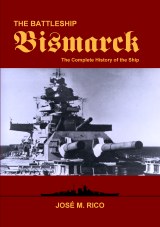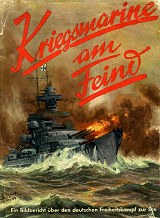 |
Home Intro Technical History Crew Models Gallery Kriegsmarine Archives
More Forum  UPDATES UPDATES |
Attachment 1 to Fleet Order 100/41 A1 Chefs.
General Orders for the Atlantic Operation.
1.) The object of the operation is to do the greatest possible damage to the enemy by destroying his merchant shipping, especially that proceeding towards England.
2.) The operation conducted with the battleships Gneisenau and Scharnhorst from January until mid-March 1941 showed that, in spite of information provided by the Intelligence Service regarding the sailing dates and routes of convoys, it is extremely difficult to intercept a convoy in the vast ocean spaces with the few units available for this purpose, and it depends on coincidence and luck.
Therefore, I do not intend to restrict the deployment of the ships exclusively for attacking convoys, but also from the outset for capturing or destroying ships steaming independently. However, as far as time permits, they will be deployed in the area of operations in such a manner that there is a prospect of intercepting a convoy.
3.) Attacks on Convoys:
Some of the convoys encountered by the battleships during the operation were escorted by a battleship and, in one case, by two cruisers and two destroyers also.
Escorts of comparable strength must be anticipated in the future.
The operational directives of the Seekriegsleitung and Group West allow Bismarck only to tie down a battleship escorting a convoy, insofar as that is possible without fully engaging, and that only in the event such action gives Prinz Eugen the possibility of success against the rest of the escort or against the convoy.
Accordingly, when Bismarck and Prinz Eugen attack a convoy, they must do so from opposite sides. In every case, tactical and attack orders will come from the Fleet Commander.
Without coming in battle contact, the exact strength of a convoy's escort can usually be determined only by shipboard aircraft. This deployment is, however, dependent upon the tactical situation and the weather and therefore rarely possible on the Halifax-England route. It must, therefore, be anticipated that, in making an attack, Prinz Eugen will encounter escorting cruisers even if Bismarck succeeds in drawing off the big ship. In this event, the cruiser's attack on the convoy is to be broken off and an immediate report made. But even when only one big ship is escorting the convoy, the enemy, if he follows good tactics, will stay in the immediate vicinity of the convoy and protect it from all sides. In this case there can be no question of an attack by the cruiser; that may occur only if the big ship allows the Bismarck to draw her so far from her charges that the cruiser has a chance of getting within effective shooting range of the convoy.
If the ships are in search sectors and Prinz Eugen sights a convoy, she should report it by short signal at close range and stay at the extreme edge of visibility (smokeless). With respect to the necessity for later surprise attacks, it cannot be the task of the cruiser to ascertain the strength of the escort. That must be left to the Bismarck. In an attack to a convoy, the main objective must be to sink as many steamers as possible. When a weakly escorted convoy is attacked, the convoy commander will certainly disperse his charges. In this case, the first objective must be to disable the largest possible number of steamers by gunfire. (They can be sunk later). For this, all batteries are to open up with the exact firing directions and at the lowest possible range appropriate to the caliber. (Main and secondary batteries with nose-fuzed and base-fuzed projectiles, heavy flak with nose-fuzed). Steamers that have been disabled by gunfire are not to be sunk until there is not one steamer still moving within sight of the ship concerned. To conserve ammunition, the heavy flak is to be nose-fuzed and used in the following manner: close within 300-500 meters of the ship, then have the best gunners fire individual shots into the waterline. Fire only when the ship is on the up-roll. Shoot holes in all of the steamer's compartments (the largest room is the engine room). With 3.7-centimeter ammunition, shoot holes in the upper part of the steamer, so that during the flooding of the rooms, air can escape upwards.
Prinz Eugen will also use her torpedoes in an attack on a convoy. Against a strongly defended convoy, there will be only a short time, if any, available for the cruiser's attack. This must be exploited as fully as possible. In this case especially, everything will depend on speedy action. The steamers are therefore to be sunk primarily with torpedoes.
The work of destruction may not be delayed by rescue operations.
The rescue of survivors, especially those from a convoy that has been attacked, can expose our own ships to serious danger from enemy submarines and surface forces. In such cases, concern for our ships must take precedence over the rescue of survivors. If necessary, a small steamer is to be spared for the purpose of rescue survivors.
4.) Ships Steaming Independently:
In the absence of orders to the contrary, all lone steamers encountered will be captured or destroyed.
When weather conditions permit boats to be lowered, the steamers will be searched and, if they themselves are valuable or have valuable cargoes and they can get under way, brought home (examine fuel supply, provisions, etc.).
In principle, tankers that can make more than 10 knots, refrigerator ships and fast motor ships, if they can get under way - whether they are laden or not - are to be captured and brought by a prize crew over the designated course (Group West Gkdos. 1803/41 AoP Chefs v. 14.4.41. Numeral 4i) into the mouth of the Gironde.
Experience has shown that it is best not to bring prizes immediately into the Bay of Biscay, especially those that have transmitted radio signals, but to wait a few weeks in a remote ocean area, then to set out for the Gironde at intervals so as to prevent the enemy from capturing them as they enter the Bay of Biscay. For this, in some circumstances it will be necessary to equip the prizes with extra provisions and send them to an escort tanker so that they can replenish. The start of the prizes' return voyage is to be reported by short signal (Short signal booklet page 20/21). Ort und Datum des Inmarschsetzens fällt fort, statt dessen ist als zweite Gruppe das gegißte Eintreffdatum der Prise im Bestinmungshafen hinzuzufügen.
Prizes must not fall into enemy hands under any circumstances. In every case, therefore, as soon as it boards, the prize crew must take preparations for scuttling at short notice.
Östlich 6º West malt das Prisenkommando Back und Heck der Prise an Oberdeck rot. (Mennige).
Bei Annäherung eigener Flugzeuge sind grüne Sterne zu schiessen.
For searching steamers, a boarding party is to be organized. Each ship has three prize crews and must organize two others from its company. Equipment is to be stored within easy reach. Prize crews must be instructed on the mission they are to discharge on board the steamers. All books, code instruments, tables, and notes found on the bridge, in the charthouse, in the radio room, in the captain's pockets, and elsewhere are to be seized and examined on board the ship by officers qualified in the language.
On approaching a ship sailing independently, fly the British ensign and keep the turrets at zero degrees to avoid arousing suspicion. Signal her to stop and forbid her to use her radio. The transmission or completion of a radio warning signal must be prevented if possible. For this, the following measures are to be taken:
-
a.) If the steamer is radioing before the ship gets within firing range, the message must be interrupted by the sending of a prepared radio message (in the English language) or a radio weather report.
As soon as the steamer is in effective range, open fire.
Whenever possible take the bridge superstructure under fire.
(On most steamers the radio room is behind or below the bridge.)
b.) If the steamer is radioing within the effective range of the heavy flak, open fire immediately and destroy her radio installation as in paragraph a.). (Flak with nose-fuzed.)
Approach a steamer so that one side is to leeward, quickly bring the ship to a stop, and lower a boat immediately (mit langer Vorleine aussetzen).
The boarding party will take over all important points (bridge, charthouse, radio room, engine room) and have the crew of the steamer assemble immediately on the upper deck.
5.) Befehl für den Kriegsmarsch.
-
a.) Gefechtswendungen sind surchzuführen, sobald Befehl verstanden.
Bei Schiffsabständen über 3000 m braucht mit dem Andrehen nicht auf das Treffenschiff gewartet zu werden.
Bei Nacht keine Wendelaternen. Ruderlage an Treffenschiff durch UK.
b.) Nebelanlage, insbesondere bei Frost, häufig durchprüfen.
c.) Abblendezustand wird bei gemeinsamen Marsch täglich nach Einbruch der Dunkelheit gegenseitig überprüft. Hierzu dampft der Hintermann an BB. auf, schert vor dem Vordermann auf die St.B.-Seite, läßt sich dort sacken und hängt sich wieder an. Ergebnis durch UK.
d.) Um der Gegner, insbesondere der feindlichen Luftaufklärung keinen Anhalt für den Marschweg der Schiffe zu geben, ist das Lenzen der Bilgen, überbordwerfen von Leergut und Entleeren der Papierkörbe nur in der Zeit von Sonnenuntergang bis 2 stunden Danach durchzuführen. Sollte außerhalb dieser Zeit der Wunsch zu Lenzen in Ausnahmefällen bestehen, so ist hierzu in jedem einzelnen Falle Genehmigung bei Flotte einzuholen.
e.) Solange die Schiffe gemeinsam operieren, wird täglich der Bereitschafts- und Kriegsmarschzustand für beide Schiffe befohlen.
Dieser Befehl ist bindend und in keiner Richtung abzuändern.

| Home Guestbook Quiz Glossary Help us Weights & Measures Video Credits Links Contact |

